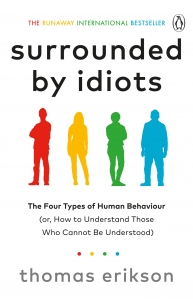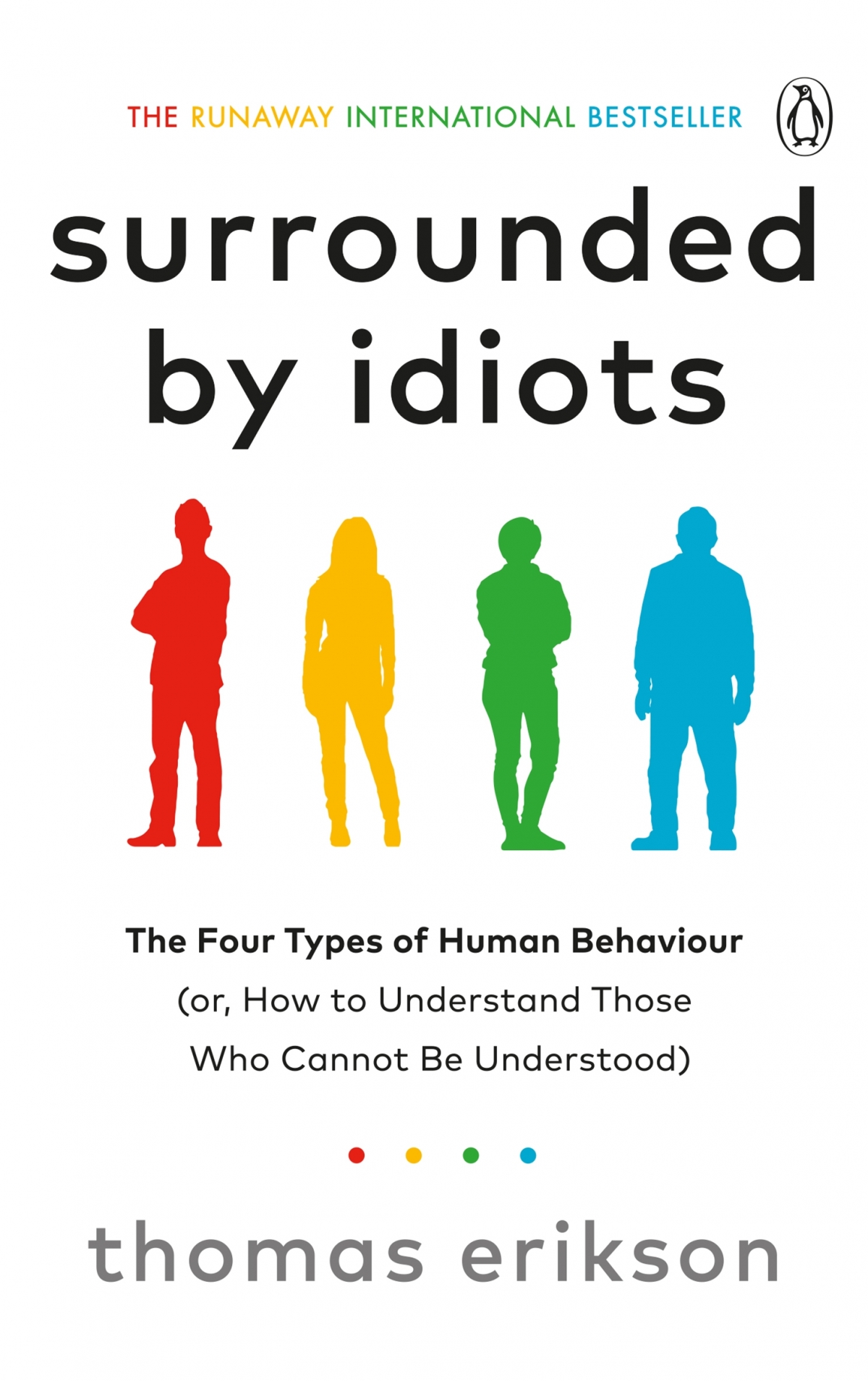
Erikson will help you understand yourself better, hone communication and social skills, handle conflict with confidence, improve dynamics with your boss and team, and get the best out of the people you deal with and manage. He also shares simple tricks on body language, improving written communication and advice on when to back away or when to push on, and when to speak up or indeed shut up. Packed with ‘aha!’ and ‘oh no!’ moments, Surrounded by Idiots will help you understand and influence those around you, even people you currently think are beyond all comprehension.
Introduction: The Man Who Was Surrounded by Idiots
“I was in high school when I first noticed that I got along better with
certain people rather than others. It was easy to talk to some of my
friends; in any conversation, we always found the right words and
everything just flowed smoothly. There were never any conflicts,
and we liked one another. With other people, however, everything
just went wrong. What I said fell on deaf ears, and I couldn’t understand
why.
Why was speaking to some people so easy, while others were total
blockheads? Since I was young, this certainly wasn’t something that
kept me awake at night. However, I still remember puzzling over why
some conversations flowed naturally, while others didn’t even
start—no matter how I conducted myself. It was just incomprehensible.
I began using different methods to test people. I tried to say the
same things in similar contexts just to see what reaction I got. Sometimes
it actually worked and an interesting discussion developed. On
other occasions, nothing happened at all. People just stared at me as if
I were from another planet, and sometimes it really felt that way.
When we’re young, we tend to think of things very simply. Because
some people in my circle of friends reacted in a normal way that
meant, of course, that they were automatically the good guys. And so
I just assumed there was something wrong with the people who didn’t
understand me. What other explanation could there possibly be? I
was the same all the time! Certain people just had something wrong
with them. So I simply began to avoid these weird, difficult people
because I didn’t understand them. Call it the naïveté of youth if you
will, but it did give rise to some amusing consequences. In later years,
however, all of this changed.
Life went on with work, family, and career, and I continued to
pigeonhole people into two groups— good and sensible people and all
the rest, the people who didn’t seem to understand anything at all.
When I was twenty-five years old, I met with a man who was self-employed.
Now in his sixties, Sture had founded his own business and
built it up for many years. I was given the task of interviewing him
just before a new project was to be implemented. We started talking
about how things were functioning in his organization. One of the very
first comments Sture made was that he was surrounded by idiots.
I remember laughing at the time because I thought it was a joke. But
he truly meant what he said. His face turned crimson as he explained
to me that the people working in Department A were complete idiots,
every single one of them. In Department B you found only fools who
understood nothing at all. And he hadn’t even come to Department C
yet! They were the worst of all! They were so weird that Sture couldn’t
fathom how they even made it to work in the mornings.
The more I listened to him, the more I realized that there was something
very odd about this story. I asked him if he really believed that
he was surrounded by idiots. He glared at me and explained that very
few of his employees were worth having.
Sture had no issue letting his employees know how he felt. He didn’t
hesitate in the least to call anyone an idiot in front of the whole company.
This meant that his employees learned to avoid him. No one
dared to have one-to-one meetings with him; he never got to hear bad
news because he would often shoot the messenger. At one of the offices,
a warning light had even been mounted at the entrance to the building.
Discreetly placed above the reception desk, the light went red
when he was there and turned green when he was away.
Everyone knew about this. Not only staff but even clients would
automatically cast a nervous glance at the light to find out what awaited
them when they stepped over the threshold. If the light was red, some
people would simply turn back at the door, deciding to come back at
a more opportune time.
As we all know, when you’re young you are full of great ideas. So
I asked the only question I could think of: “Who hired all these idiots?”
I knew, of course, that he had hired most of them. What was worse
was that Sture understood exactly what I had implied. What I implicitly
asked was: Who is actually the idiot here?
Sture threw me out. Later on, I was told that what he really wanted
to do was fetch a shotgun and shoot me.
“It was an utterly appalling thought to have to go through life constantly thinking that I was surrounded by people who were impossible to work with. It would make my own potential in life so unbelievably limited.”
This incident got me thinking. Here was a man who would soon
retire. He was obviously a proficient entrepreneur, highly respected
for his sound knowledge of his par tic u lar line of business. But he
couldn’t handle people. He didn’t understand the most critical, complicated
resource in an organization—the employees. And anyone he
couldn’t understand was simply an idiot.
Since I was from outside the company, I could easily see how wrong
his thinking was. Sture didn’t grasp that he always compared people
to himself. His definition of idiocy was simply anyone who didn’t think
or act like him. He used expressions that I also used to use about certain
types of people: “arrogant windbags,” “red- tape jackasses,” “rude
bastards,” and “tedious blockheads.” Although I never called people
idiots, at least not so they could hear me, I had obvious problems with
certain types of people.
It was an utterly appalling thought to have to go through life
constantly thinking that I was surrounded by people who were impossible
to work with. It would make my own potential in life so
unbelievably limited.
I tried to see myself in the mirror. The decision was easy to make.
I didn’t want to be like Sture. After a particularly toxic meeting with
him and some of his unfortunate colleagues, I sat in the car with a lump
in my stomach. The meeting had been a total disaster. Every one was
furious. There and then I decided to learn what is prob ably the most
important knowledge of all—how people function. I would be encountering
people for the rest of my life, no matter what my profession
was, and it was easy to see that I would benefit by being able to
understand them.
I immediately began to study how to understand the people who
initially seem so difficult. Why are some people silent, why do others
never stop talking, why do some people always tell the truth while
others never do? Why do some of my colleagues always arrive on time,
while others rarely manage to? And even why did I like some people
more than others? The insights I gained were fascinating, and I’ve
never been the same since I began this journey. The knowledge I acquired
has changed me as a person, as a friend, as a colleague, as a
son, as a husband, and as the father of my children.
This book is about what is perhaps the world’s most widely used
method to describe the differences in human communication. This
method is called the DISA—an acronym that stands for Dominance,
Inducement, Submission, and Analytic ability— system. These four
terms are the primary behavior types, which describe how people
sees themselves in relationship to their environment. Each of these behavior
types is associated with a color— Red, Yellow, Green, and Blue.
This system is also commonly called the DISC system, where the final
letter of the acronym stands for Compliance instead of Analytic ability.
I have used variations of this tool for over twenty years with excellent
results.
But how do you become really, truly proficient at handling different
types of people? There are, of course, various methods. The most
common method is to research the matter and learn the basics. But
learning the theoretical part doesn’t make you a world-class
communicator.
It’s only when you begin using this knowledge that you can
develop real and functioning competence in the field. Just like learning
to ride a bike— you have get on the bike first. Only then do you
realize what you need to do.
Since I began studying how people function and painstakingly
strove to understand the differences in the way we communicate, I’ve
never been the same. I’m not as categorical anymore, judging people
just because they are not like me. For many years now, my patience
with people who are the complete opposite of me has been far greater.
I wouldn’t go so far as to say that I never get involved in conflicts,
just as I wouldn’t try to convince you that I never lie, but both these
things happen very seldom now.
I have one thing to thank Sture for—he awakened my interest in
the subject. Without him, this book would prob ably never have been
written.
What can you do to increase your knowledge about how people
relate and communicate? A good start may be to keep reading this
book— the whole book, not just the first three chapters. With a little
luck, in a few minutes you can begin the same journey I began twenty
years ago. I promise you will not regret it.
One thing to note: To simplify reading this book, I have chosen to
use “him” and “he” consistently when I refer to examples not associated
with any specific person. I know that you have enough imagination
to insert a “her” or “she” in your thoughts where this may be
appropriate.”
Extracted from Surrounded by Idiots by Thomas Erikson, out now.
YOU MAY ALSO ENJOY
Extract: Grit by Angela Duckworth









